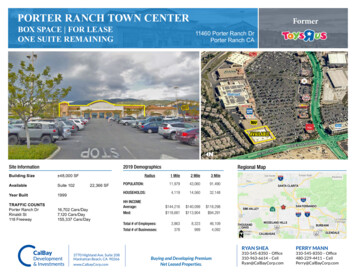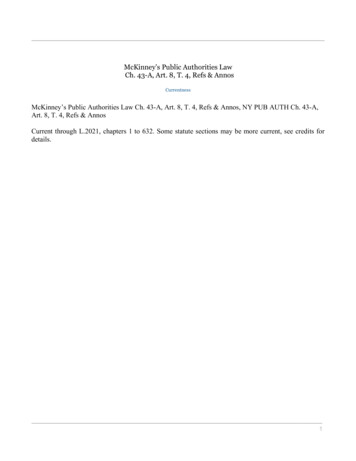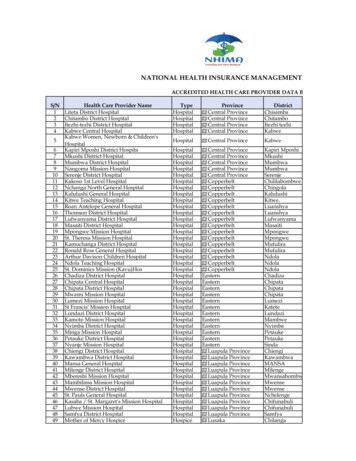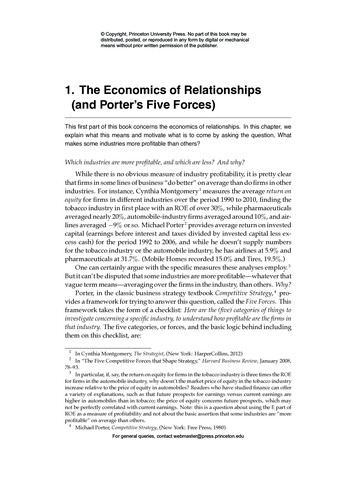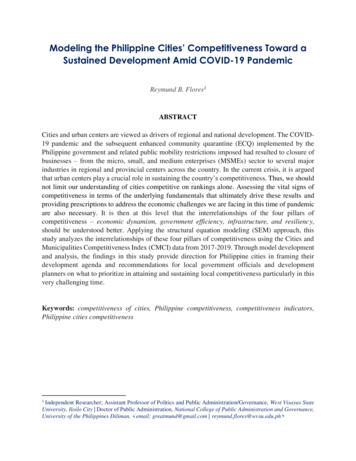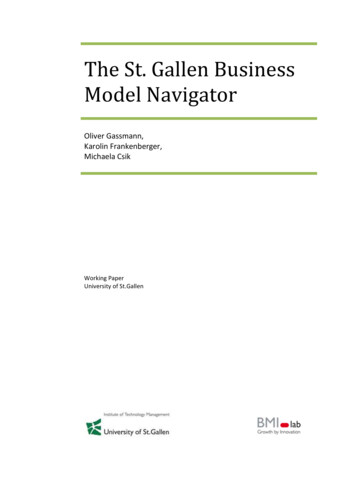
Transcription
OO11-4POLICY TITLE: Hospital Plan of Care Index (PAH)DEPARTMENT: CEO-AdministrationCATEGORY: CEO-AdministrationORIGINATION DATE: 05/01/1997EFFECTIVE DATE: 10/08/2012I. MissionCentura Health Mission StatementWe extend the healing ministry of Christ by caring for those who are ill and by nurturing the health of thepeople of our communities.Centura Health Core Values Integrity: Honesty, directness and respect for commitments made. Stewardship: Respectful use of all natural, human and financial resources. Spirituality: Acknowledgement of its central role in facilitating mental, physical and emotional health. Imagination: Creativity and innovation in all we do. Respect: Respect for all persons and for our Christian identity, heritage and missions of our sponsoringorganizations. Excellence: Striving to exceed the clinical quality, customer service and cost performance expectationsof our customers. Compassion: Sensitivity and responsiveness to persons in need.Centura Health Vision StatementCentura Health will fulfill a covenant of caring for our communities with excellence and integrity to becometheir partner for life.II. Definition of Patient Care, Patient Services and Patient Support ServicesPorter Adventist Hospital (PAH), under the management of Centura Health and the sponsorship of theAdventist Health System, recognize that the well-being of the individual presenting for healthcare servicesis our highest obligation. Because of this commitment, the departments and services of the hospitals areorganized and integrated so as to optimize our ability to provide safe, effective, appropriate and timelycare and treatment. Coordination and collaboration occurs between providers of patient care asindividuals, departments and services.Patient Care is directed by healthcare professionals who are responsible for assessment of the patient'sneed for care and for planning the patient's care based upon assessment findings.
OO11-4Patient Services are those services provided through direct contact with the patient and family members,through the provision of direct Patient Care.Patient Support Services are those services which support the care provided by direct care providers, andwhich may or may not involve some direct contact with the patient and/or family members.Patient Care encompasses both the facilitation of healing and the promotion of health. The provision ofPatient Care requires the integration of biological, psychological, social and spiritual health care needs. Theprofessionals who provide, coordinate, delegate and supervise Patient Care must therefore possess skills,knowledge and judgment within each of these domains. Furthermore, these professionals must functioncollaboratively as part of a multidisciplinary team in order to achieve holistic care and optimum patientoutcomes.III. Professional Patient Care Staff ResponsibilitiesJOB TITLEChaplainsAssessmentxDisch.PlanxAccess toServicesNutritionOper.InvasiveProc.xRadiation xxNurse xxxxxxxxxxxxDevelopmentalTherapistsDiagnostic ImagingTechsxDietitiansxxxxRegistered NursesxxxxCase ManagersxxxxSocial Worker – CaseMgrsxxxx
OO11-4JOB TITLEAssessmentDisch.PlanAccess peech tRightsPatientTeachingPatientTreatmentxxxxxxxxxIV. Patient ServicesPatient Services are those inpatient and outpatient services that provide Patient Care according to thedefinition above and where services are rendered by the professional staff described above. The deliveryof Patient Care is supported by functional patient services.Patient Care ServicesBehavioral Health Behavioral Health Inpatient Units The Centre ECT The Psychiatric Assessment TeamCardiovascular Cardiovascular and Electrophysiology Lab Cardiac Telemetry Unit Cardiac Short Stay Cardiac Diagnostics Heart Failure Clinic Cardiac Rehabilitation Cardiac Early DetectionEmergency Services The Emergency Department Pre-hospital ServicesEnterstomal
OO11-4 Enterstomal TherapyOncology and Clinical Support Oncology Unit IV Therapy Infusion Center Radiation Therapy Breast Care CenterMedical/Surgical Care Medical Unit Respiratory Care Surgical Unit Critical Care Medical/Telemetry Orthopedics: Joint Replacement and SpineRehabilitation Occupational Therapy Physical Therapy Rehabilitation Unit Speech-Language Pathology & AudiologySurgery Perioperative ServicesWomen Services Women’s SurgeryWound Care Wound Care ClinicPatient Support ServicesCase ManagementChaplain Services (Pastoral Care)Dialysis
OO11-4Home Care (Centura Health at Home)HospiceLaboratoryMedical ImagingNeurodiagnostic LabNuclear MedicineNutritionPatient Care Resource CenterPatient and Family EducationPharmacyRespiratory TherapySocial Work/Discharge PlanningTransplantV. StandardsPatient Care Services - Standards are developed, maintained and followed by all Patient Care Departments.These standards define what professionals will do for patients and what patients will receive from theprofessionals caring for them. In addition, all Patient Service Departments will adhere to the following:The staff will do the right procedures, treatments, interventions and care, at the right time and in the rightway. All patient care will be provided according to our Mission and in a manner that is safe,compassionate, efficacious and appropriate. Care will be provided based upon patientassessment/reassessment and knowledge-based practice, with respect for patient rights and that adheresto our healing ministry. Care will be guided by relevant policies, procedures and protocols which aresupported by current evidence to provide optimal patient care.Standards of CareThe patients of PAH can expect to receive the following:STANDARD I - Patients can expect nurses to provide appropriate nursing care during hospitalization and toprepare them for discharge.STANDARD II - Patients can expect to have their needs for privacy respected and information about themkept confidential.STANDARD III - Patients can expect to have their educational needs and abilities assessed and instructionsprovided consistent with those needs and abilities.STANDARD IV - Patients can expect to have their psychosocial needs addressed during hospitalization andthrough the discharge plan.
OO11-4STANDARD V - Patients can expect to have their pain assessed and receive appropriate pain managementthroughout hospitalization.STANDARD VI - Patients can expect nursing care to be provided within a safe environment.STANDARD VII - Patients can expect to be protected from nosocomial infections throughout hospitalization.STANDARD VIII - Patients can expect to have their skin integrity assessed and maintained throughouthospitalization.STANDARD IX - Patients can expect to have their hydration needs assessed and maintained throughouthospitalization.STANDARD X - Patients can expect to have their nutritional status assessed and a diet provided asprescribed.STANDARD XI - Patients can expect to have their cardiovascular status assessed and maintained throughouthospitalization.STANDARD XII - Patients can expect to have their respiratory status assessed and maintained throughouthospitalization.STANDARD XIII - Patients can expect to have their neurological status assessed and maintained throughouthospitalization.STANDARD XIV - Patients can expect to have their musculoskeletal status assessed and maintainedthroughout hospitalization.VI. Staffing PlansStaffing plans for Patient Care Departments are developed based on the level and scope of care that isprovided, the frequency of care provided, and the qualifications of staff who can most appropriatelyprovide the care required.Each Patient Care Department will have a staffing plan which will be reviewed annually.VII. Patient Support ServicesOther essential services are provided by Patient Support Services to ensure that direct patient care andrelated services are provided in an uninterrupted manner, and to support the comfort and safety of thepatient and the efficiency of services provided. In addition, these services include those departmentswhose functions safeguard the ability of the hospitals to continue to provide care in the future to ourcommunity.Patient Support ServicesAdministrationAdmissions/Registration
OO11-4Bio-Med/Clinical EngineeringEmployee Assistance ProgramEmployee Health ServicesEnvironmental ServicesFacilities ManagementFinance (General Accounting, Decision Support, Patient Financial Services)Health AdvisorHealth EthicsHealth Information Management (Medical Records, Transcription)Human ResourcesInfection ControlInformation TechnologyLinen & LaundryMarketing/Communication Services/Provider RelationsMateriel Management/Supply Chain/Value Analysis/Value OptimizationMedical LibraryMedical Staff OfficeNursing AdministrationOutreach ServicesPatient RepresentativePerformance Services/Education DepartmentPhone CenterPlant ServicesPublic RelationsQuality ManagementRisk ManagementSafety ManagementSecurityVolunteer ServicesVIII. Responsibilities of PAH Leadership and DirectorsOther hospital services will be available and provided to ensure that direct patient care and services aremaintained in an uninterrupted and continuous manner, by coordinating identified organizational functionssuch as: leadership/management, information systems, human resources, environment, infection control
OO11-4and organizational performance improvement. These services support the comfort and safety of thepatient and the efficiency of services available. These support services will be integrated with the patientservices departments of the hospitals.The hospital Administrator, through the Vice Presidents and Department Directors, provides for theimplementation of organization, management and administrative functions throughout the hospital,including the establishment of clear lines of responsibility and accountability within departments andleadership staff. This will be carried out by the development and ongoing maintenance of a hospitalorganizational chart, ongoing communication periodic review of management systems by administrativestaff and a performance review system to insure that performance standards are set and acted on.The PAH leadership is defined as the Board of Trustees, the executive leadership, the management staff,and physicians in appointed or elected leadership positions. The PAH leadership will be responsible forproviding a framework for planning health care services provided by the organization based on thehospitals mission statement and for developing and implementing an effective planning process that allowsfor defining timely and clear goals. The planning process includes a collaborative assessment of ourcustomers and community health care needs, defining a strategic plan, developing operational plans,establishing annual operating budgets and monitoring compliance, establishing annual and long rangecapital budgets, monitoring, and establishing resource allocation and policies, and ongoing evaluation ofthe implementation and success of the plans.The planning process addresses both patient care functions (access, treatment, patient rights, patientteaching, discharge planning, and assessment) and organizational support functions (information systems,infection control, safety, environment, and performance assessment and improvement).A. The PAH leadership is responsible for: Ensuring collaboration with community leaders and organizations to design services to be provided bythe hospitals scope and level of care required by the patients we serve. Communicating the hospital's mission, goals, objectives, and strategic plans across the organization. Establishing standards of care that all patients can expect and which can be monitored through thehospital's performance and improvement plan. The performance and improvement plan is approved bythe hospital's leadership and is designed to be able to prioritize areas for improvement and to adjustand re-prioritize in response to unexpected events. Ensuring a uniform delivery of patient care services provided throughout the hospital. Providing appropriate job enrichment, employee development and continuing education opportunities(internal and external) which serve to promote retention of staff and to foster excellence in patientcare and support services delivery. Providing appropriate direction, management, and leadership of all services and/or departments. Ensuring staffing resources are available to appropriately meet the needs of the patients served. Striving to implement and maintain systems in place which promote the integration of services that
OO11-4support the patients' continuum of care needs in a way which makes sense to the consumer. Appointing appropriate committees, task forces, and other forums to ensure interdepartmentalcollaboration on issues of mutual concern and requiring multidisciplinary input.B. Each department Director is responsible for: The integration of the department/service into the primary functions of the organization. The coordination and integration of interdepartmental and intra departmental services. The development and implementation of policies and procedures that guide and support the provisionof services. Determination of the qualifications and competency of department/service personnel. Securing a sufficient number of qualified and competent persons to provide care/service. The continuous assessment and improvement of the quality and safety of care and services provided. The maintenance of quality control programs, as appropriate. The orientation and continuing education of all persons in the department/service. Recommendations for space and other resources needed by the department/service.IX.Communication PlanBecause effective communication is essential to the operations of a hospital, a formal communication planwill be in effect and maintained. The following are communication mechanisms:Interdepartmental:Performance Excellence Council, People Council, Clinical ManagementCouncil, Leadership Council, Professional Development Council, EvidenceBased Practice & Research Council, Spiritual Care Committee.Administration:Leadership Council, Medical Staff Committees, general employeemeetings, individual meetings with department directors.Medical Staff:Executive Committee, Credentials Committee, Pharmacy & Therapeutics,Infection Prevention Committee, Medical Records/Clinical PertinenceGroup, CME Committee, departmental meetings, general staff meetings,physician membership on Board, and Board committees, physiciannewsletter, physician bulletin boards in lounges.Nursing and ClinicalDisciplines:Clinical Management Council, Nursing Practice Council, Advanced PracticeCouncil, Professional Development Council, Evidence Based Practice &Research Council
OO11-4Board:Board of Trustees meeting, Centura Board meetings.Informal communications that relate to planning, problem solving and non-business related areencouraged among all staff levels. Also, all departments are encouraged to hold monthly departmentmeetings or establish other communication mechanisms.X. Integration of Patient Service and Patient Support ServicesIntegration within Patient Services is based upon a multidisciplinary, collaborative approach to care, whichtakes into account the distinctly unique knowledge, judgment and skills of various healthcare disciplines.Respect, cooperation and collegiality are to be the hallmarks of interdisciplinary collaboration.In addition, cooperation and a customer-first focus are to characterize all interactions between PatientServices and Patient Support Services. Open lines of communication are to be fostered between all hospitaldepartments and, as appropriate, with community agencies, in order to ensure safe, efficient, effective andseamless patient care.To facilitate effective interdepartmental relationships, problem-solving is encouraged at the level at whichthe problem is identified. Staff is to be receptive to hearing the concerns of others and are to regardconflicts as an opportunity to achieve improvement. Managers and coordinators have the authority tocollaboratively seek solutions and solve problems within their spans of control.When a problem identified involves two or more areas providing patient services or patient support,department heads may elect to establish an interdisciplinary task force with representatives from the areasinvolved for the purpose of identifying improvement-based solutions. In addition, the ClinicalExcellence Council may seek solutions to interdepartmental issues through the chartering of processimprovement teams.XI. Roles and Functions within Integrated Patient Service Lines, Functional Patient Services, and PatientSupport ServicesRoles and Functions are described below according to:A.A.Patient Servicespage 11B.Patient Support Servicespage 24PATIENT SERVICES –1. Behavioral Healtha. Behavioral Health Inpatient Unit (PAH)The Behavioral Health program offers inpatient (ages 19 and older) and outpatient services forchildren, adults and geriatric clients. The programs medical director is a psychiatrist.
OO11-4The inpatient units offers a short-term, acute care program utilizing a multidisciplinary teamapproach. Nursing staff provides 24 hour care and is responsible for the ongoing care of thepatient and providing individual and group therapies. Social services obtains a psychosocial historyfrom each patient and participates in discharge planning. The physician is responsible for theoverall direction of the patients care. The case manager provides ongoing utilization review andpre-authorization of patients.As part of our community service we provide in-service education for nursing departments,educational programs for the community and provide space for self-help groups.The IOP (Intensive Outpatient Program) is for those patients who need a transition from 24-hourcare to home or who need intensive treatment and not inpatient care.The ECT program provides electronconvulsive therapy for psychiatric disorders for which thistreatment is indicated. Treatments are administered by a psychiatrist trained and qualified toadminister this procedure. Treatments are administered in the operating roomwith anesthesiology in attendance according to standard and accepted practices. The procedure isadministered to both inpatients and outpatients.b. The CentreThe Centre for Behavioral Health is an outpatient treatment facility. It provides general psychiatricservices including: a chemical dependency program, a medication clinic, individual andmarriage/family counseling, and aftercare programs. Services are provided to patients ages 4 toadult.c. The Psychiatric Assessment ServiceWe provide 24-hour psychiatric coverage of the emergency department, medical floors andintensive care unit for assessment, disposition or referral. We also provide assessment andconsultation for other nursing departments.2.Cardiovasculara. Cardiovascular Lab and Electrophysiology LabScope of Care: The Cardiovascular and Electrophysiology Lab provides services for adult cardiacpatients. The services include: diagnostic and interventional procedures, services for adultpatients with arrhythmias which are treatable by Electrophy studies. The procedures includeablations, ventricular tachycardia studies, plus implementations of pacemakers and ICD’s. Hoursare from 7:00 a.m. - 4:30 p.m. However a call team is available for after hour emergencies, 24hours/day, 7 days/week. The staff in this area is composed of RN’s, RT’s, RCVT’s, RCIS.b. Cardiac DiagnosticsScope of Care: The Cardiac Diagnostics Lab offers the following services to adult inpatients andoutpatients: electrocardiograms, cardiac stress testing, echocardiograms, holter monitors rhythm
OO11-4event monitors. The lab is designed to perform specific non-invasive cardiac testing to assist in thediagnosis and treatment of various cardiac clinical issues. The hours for outpatients are from 7:00a.m. – 3:30 p.m., Monday-Friday. There is 24-hour coverage for EKG’s and echocardiograms toserve the inpatient population.c. Critical Care AreaScope of Care: The CCA’s provide 36 beds for specialized nursing care of adolescent and adult forpatients who are critically ill with complex medical problems, postoperative surgery or thoracicsurgery, vascular surgery, postoperative general surgery, or postoperative renal/livertransplantation.The nursing staff includes registered nurses, certified nursing assistants, monitor technicians andunit coordinators.Nursing care in both units is delivered within the framework of the nursing process using a staffingratio of 1:1, 2:1 or 3:1 based on patient acuity, nursing judgment and demonstrated nursing skill.d. Cardiac Telemetry UnitScope of Care: The Telemetry unit is a 25 bed unit, operating on a 24 hour basis, located on thenorth wing of the fifth floor. The unit provides specialized nursing care to adolescent and adultpatients who are acutely ill with cardiac problems and no longer require the close observation ofthe Critical Care Units, but continue to require telemetry monitoring. The unit provides care forinpatients to assist them in attaining the highest level of wellness possible and to include thepatient, significant other and other support systems as appropriate. Patients under the age of 17may be cared for on the cardiac telemetry unit based on evaluation of patient needs by the nursemanager/director of cardiovascular care services and the attending physician.The staff includes nurse practitioners, registered nurses, certified nursing assistants, unitcoordinators and monitor technicians.Nursing care on 5N is delivered within the framework of the nursing process using a staffing ratio of5-6:1 based on patient acuity, nursing judgment and demonstrated nursing skill. Special servicesinclude telemetry monitoring, cardioversions, management of non-titrated IV cardiovasculartherapeutic medications.e. Heart Failure ClinicHeart Failure is currently Medicare's most frequent and expensive diagnosis, accounting for nearly6.5 million hospital days annually. In an attempt to reduce hospital admission rates and associatedhealthcare costs, Porter Adventist Hospital offers an outpatient Heart Failure clinic to providecloser guidance and monitoring of Class 3/Class 4 HF patients. This nurse practitioner run clinic,under the guidance of the patient's primary physician and cardiologist, is able to monitor patient'sfluid status, laboratory values, and heart failure symptomatology and to modification currentmedication and treatment regimens to insure continued heart failure compensation.f. Cardiac Short Stay
OO11-4The Cardiac short stay unit focuses on treatment of low risk chest pain patients. Patients stay in aquiet separate area in the emergency room while waiting for treadmill testing, which is offereduntil 2300 hours. This team oriented approach with designated cardiac nurse practitioners allowsexpedited care, decreasing hospital admissions.g. Cardiac Early DetectionThe Cardiac Early Detection Program at Porter Adventist Hospital provides you with theconvenience of state-of-the-art cardiac diagnostic testing coordinated by a program provider. Thiscomprehensive testing takes an individual approach that allows patients and physicians to choosewhat best meets the client's needs. These preventative screenings may involve advanced lipidtesting, CT Calcium Score, Coronary CTA, echocardiogram, EKG testing and individualizedcounseling.3. Complex Medicinea. Medical UnitsScope of Care: The Medical Units include one 20 bed unit, operating on a 24 hour basis, located onthe east wing, fifth floor. The medical unit accepts adolescent and adult patients with medicalillnesses with single to multiple interruptions in body systems. Patients may have medicalconditions such as diabetes, cancer, infections, alterations in cerebrovascular function, and cardiorespiratory disease. Patients under the age of 17 may be cared for on the medical unit based onevaluation of patient needs by the assistant nurse manager/director of primary care services andthe attending physician.The units also care for dual diagnosis patients with concurrent medical and psychiatric disease. Thenursing staff includes clinical coordinator, registered nurses, certified nurse assistants and unitcoordinators.Nursing care is delivered within the framework of the nursing process using staffing andassignments based on patient acuity, nursing judgment and nursing skill.b. Respiratory CareScope of Care: Respiratory personnel provide services in general care, emergent care, critical careand specialty areas. Patients are classified inpatient or outpatient.Staffing for Respiratory Care Services is determined per department policy. Qualified personnel areon duty 24 hours per day to provide assessment and treatment for neonate, pediatric, adolescent,adult and geriatric patients. On a shift by shift basis staff number and mix is determined by workunits, patient acuity and specialty needs (i.e. diagnostic procedures, specialty ventilatormanagement).4. Rehabilitationa. Occupational Therapy
OO11-4The Occupational Therapist plays a contributing role in the rehabilitation of physically,neurologically, cognitively and/or physiologically impaired individuals to include the evaluation andtreatment including, but not limited to, activities of daily living, work and leisure activities, sensorymotor function, functional, perceptual, cognitive, physical, behavioral, communication and socialneeds. Based on the assessment, the patient can expect individualized therapeutic interventions,which, may include, but are not limited to, the following modalities: ADL training, therapeuticactivities, education or other procedures, incorporating the patient’s and/or families goals andexpectations. Specific patient and family education is also expected to result in the patientachievement of individually determined goals and expectations with optimal function andintegration into the community at the time of discharge. In addition, the special needs of thepatients who are possible victims of alleged or suspected abuse/neglect will be addressed. TheOccupational Therapist follows the principles set out in the Occupational Therapy Code of Ethics.Scope of Care: Occupational Therapy Services provided include, but may not be limited to,screening/evaluating activities of daily living, cognitive and perceptual deficits, work site analysisand orthopedic/neurologic impairments. The purpose is to prevent or minimize residual physicaland cognitive disabilities; to aid the patient in achieving his maximum potential within hiscapabilities; and to reduce the length of the functional recovery.These services will be delivered in a timely fashion in accordance with professional standards ofpractice, departmental policies and procedures and hospital standards.Skill Levels: Occupational Therapists (B.S. or M.S. from an accredited school, licensed in the State ofColorado and registered from the National Occupational Therapy Certification Board), and CertifiedOccupational Therapy Assistants (Associate Degree from an accredited program and Certificationfrom the National Occupational Therapy Certification Board).Staffing Plan: Refer to the physical medicine policy manual/Meditech forms.b. Physical TherapyScope of Care: Physical Therapy is a patient care service provided in response to a wide range ofrehabilitation care needs of inpatients and outpatients of all ages, regardless of race, color, creed,nation origin, gender or disability, five days a week for outpatients, seven days a week forinpatients and seven days a week for wound care patients. Inpatient and Skilled Nursing PhysicalTherapy will be provided at the bedside, Independence Square or in the Physical TherapyDepartment as appropriate. Outpatients will be seen in the Outpatient Physical TherapyDepartment.Outpatient Physical Medicine Services will be available Monday-Friday 7:00 a.m. to 4:00 p.m.Inpatient Physical Medicine Services are available Monday-Friday 7:30 a.m. to 4:30 p.m. andSaturday-Sunday 7:30 a.m. to 4:00 p.m.Physical therapy included the examination, treatment, and instruction of human beings to detect,assess, prevent, correct, alleviate and limit physical disability, bodily malfunction, and pain frominjury, disease and any other physical or mental conditions. It includes the administration,interpretation, and evaluation of tests and measurements of physical abilities, bodily functions andstructures; the planning, administration, evaluation and modification of treatment and instruction,
OO11-4including the use of physical agents, measuring devices, activities, and equipment for preventativeand therapeutic purposes. Physical therapy also provides consultative, education and otheradvisory services for the purpose of reducing the incidents and severity of physical disability, bodilymalfunction, pain, and community education. Physical therapy procedures educate the patient inmaking maximal use of his/her complete residual capabilities and to enable him/her to obtainoptimal satisfaction and level of function in terms, of self, family, and community. In addition, thespecial needs of the patients who are possible victims of alleged or suspected abuse to beaddressed.Skill Levels: Physical Therapists (Bachelors, Masters or Doctorate) from an accredited school andlicensed in the State of Colorado). Physical Therapy Assistants (Associate Degree and preferredlicensure from adjoining states). Physical Therapy Technician (High School Graduate/GED).Staffing Plan: Refer to the physical medicine policy manual/Meditech forms.c. Inpatient Rehabilitation UnitScope of Care: The inpatient rehabilitation unit at
hospital's performance and improvement plan. The performance and improvement plan is approved by the hospital's leadership and is designed to be able to prioritize areas for improvement and to adjust and re-prioritize in response to unexpected events. Ensuring a uniform delivery of patient care services p rovided throughout the hospital.


